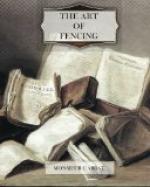[Illustration: 10th Plate. The Turning the Body on a Pass in Tierce.]
[Illustration: Pass in Seconde Volting the Body.]
To Pass in Tierce.
In passing Tierce, as in a Lunge, the Wrist must draw the Shoulder and Body forward, bringing, as in a Pass in Quarte, the Left-foot about two Feet and an Half before the Right, then advancing the Right foremost and out of the Reach of the Enemy’s; you must seize the Guard of his Sword, and again advancing the Left-foot near the Right, you draw back the Right and present the Point.
The Counters or Opposites to this Pass, are the strait Rispost, or the Rispost under, the taking Time, cutting Seconde under, disengaging, or counter disengaging and volting, but the surest is to loosen the Right-foot turning the Body half round to the right, opposing with the Sword and presenting the Point to the Enemy, which hindering him from hurting you, throws him on your Point if he abandons himself, and at the same time you seize the Guard of his Sword. See the 10th Plate.
To Pass in Seconde.
In passing Seconde, there must, as in a Lunge, be a preparatory Motion, which is made by a Feint, or by an Engagement on the Blade to oblige the Enemy to parry high, in order to take that Time to pass under, which is done by advancing the Left-foot very much, with the Body lower and more forward than in other Passes, and advancing the Right-foot, you seize the Enemy’s Sword, bringing yours from under over, and advancing the Left-foot to the Side of the Right, you draw back the Right presenting the Point. You must take notice, that in a Pass in Quarte with it’s Joining, there are but three Steps, and that in the Passes in Tierce and Seconde there are four. The first, passing the Left-foot before the Right; the second, advancing the Right to seize the Sword; the third, bringing up the Left-foot a little, and the fourth, bringing back the Right, presenting the Point.
In order to avoid, and to hit the Enemy on his Pass, besides parrying and pushing strait, as in the Thrust lunged in Seconde, in the 6th Plate, you may also make a strait Thrust, opposing with the Left-hand, or by volting, as is shewn in the Cut of the 10th Plate.
Tho’ a Pass carries along with it, as I have observed, a greater Extension and Swiftness than a Lunge, yet as you cannot recover from it, it should be seldom practised, especially if you are not the strongest, or able in three attacks to hit twice, there being nothing more disagreeable to the Sight than to see several Passes made without hitting. But it is otherwise in Lunges, by reason of the Liberty of recovering and parrying.
Passes were more used formerly than they are now, whether it was to endeavour to bring them to Perfection, or because it has been found that this Sort of Play was not so sure.




